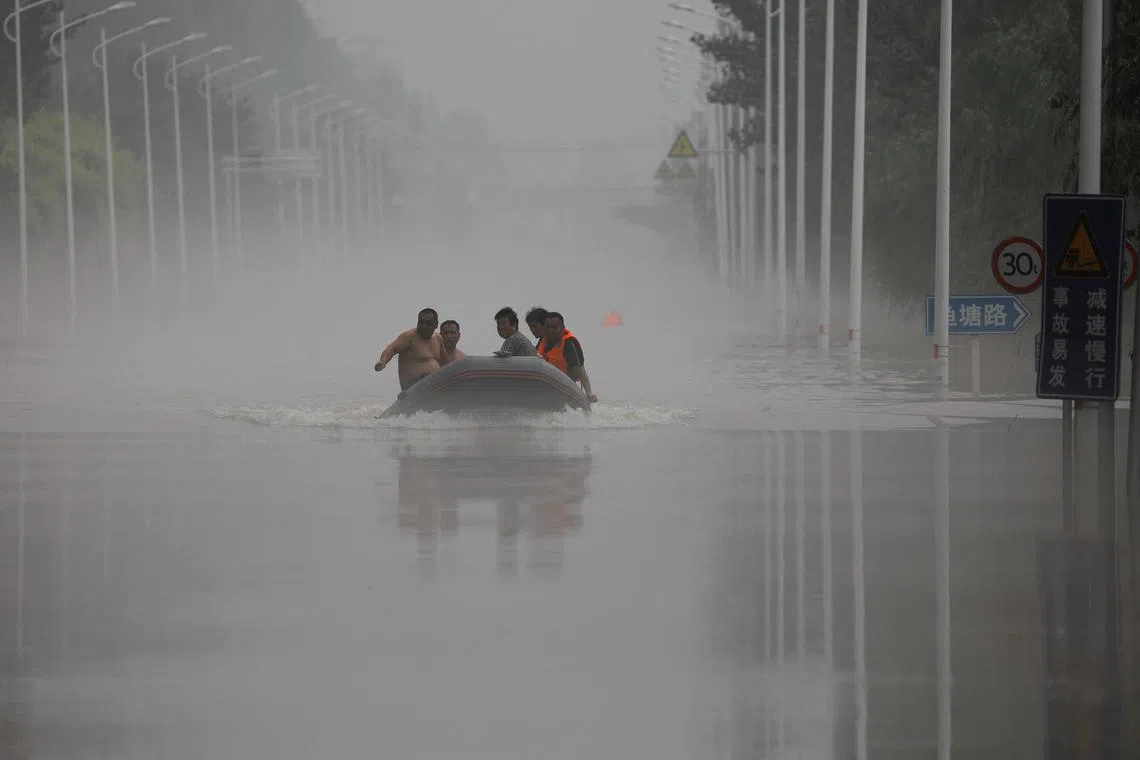China’s north-east inundated in typhoon’s wake; heavy rain wreaks havoc in central Taiwan
Sign up now: Get ST's newsletters delivered to your inbox

Rescuers take a rubber boat through a flooded street in Zhuozhou city, Hebei province, China.
PHOTO: REUTERS
Follow topic:
SHENZHEN – Flood waters from Typhoon Doksuri continued to deluge farms and cities in north-east China into the weekend, with the country’s disaster relief systems struggling to deal with the aftermath of one of the strongest storms in years.
Almost 15,000 residents were moved out of Shulan, a city of more than 700,000 in corn-growing Jilin province, where one person died and four others were missing.
Rain has fallen continuously in Shulan since Tuesday, with some areas getting 489mm of rainfall, five times the previous record. Bridges have collapsed and roads were damaged across the city. State news agency China News Service showed images of waterlogged streets around factories and homes.
The record-breaking rains arrived in late July as the remnants of Typhoon Doksuri moved inland, battering northern China and causing massive floods, disrupting the lives of millions.
Around 1.54 million people had been evacuated from at-risk areas in north China’s Hebei province as at Saturday morning, Xinhua reported.
In Beijing, the city authorities on Saturday warned of sinkholes and mudslides in the capital’s Fangshan and Mentougou outer districts.
Rainfall this past week broke many records in Beijing and northern China, with the vast Haihe river basin hit with its worst flooding since 1963.
Flood waters could take up to a month to recede in Hebei province, a water resources department official told state media.
On Saturday, water levels in Zhuozhou to the south-west of Beijing began to drop, with search and rescue and flood drainage efforts continuing in Hebei province’s hardest-hit city. Around 100,000 people – a sixth of its population – have been evacuated.
In Baoding prefecture, to which Zhuozhou belongs, record rainfall led to the overflow of 67 of its 83 smaller reservoirs, the collapse of more than 4,000 houses and the death of at least 10 people, the Baoding government said on Saturday.
Nearly 300 bridges and over 550km of rural roads have been damaged by water, the government said, with Baoding’s direct economic losses reaching nearly 17 billion yuan (S$3 billion) as at Saturday.
In July, China’s direct economic losses from natural disasters surged to 41.18 billion yuan, more than the total for the previous six months, after two powerful typhoons during the month.
On Saturday, the authorities of Bazhou city in Hebei expressed “heartfelt thanks” to residents for evacuating their homes in an area where flood waters had been diverted for storage, and said a review for disaster compensation for damaged agricultural production and housing would take place when the flood recedes.
Heavy rain pounds Taiwan
Intense rain in the wake of Typhoon Khanun, meanwhile, lashed the mountainous parts of Taiwan on Saturday, unleashing floods and landslides that blocked roads and stranded hundreds of people as the authorities rushed to resume transportation links.
Rain has pounded the central county of Nantou since Typhoon Khanun brushed past northern Taiwan on Thursday, with more than a metre of precipitation soaking Ren’ai township since then, shattering roads and triggering landslides and mudslides.
Local news footage showed a petrol station in Ren’ai buried by landslides, while a motorway nearby was flooded, cutting the key transportation link in the mountainous area.
Across Taiwan, two people were missing and more than 460 stranded, mostly in remote mountainous areas, the government said, adding that no casualties have been reported.
Ms Hsu Shu-Hua, head of Nantou County, said some people were stranded on the mountains and urged the central government and armed forces to send help as soon as possible.
Vice-President William Lai vowed to provide “greatest resources” to help the local authorities restore infrastructure and transportation. REUTERS

